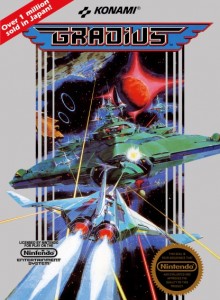317th played so far
 Genre: Shoot ‘Em Up
Genre: Shoot ‘Em Up
Platform: Arcade
Year of Release: 1985
Developer: Konami
Publisher: Konami
Our original plan for today was actually to play Salamander, but on further reading we found out that it had a prequel, Gradius (or Nemesis in most non-Japanese arcade versions), and is a part of a longer series. As we had the chance anyway, we figured we might as well start with it. A few more months of waiting never hurt anyone…
Gradius’ claim to fame is apparently its weapon selection bar, although graphically it was advanced for its time as well. Beyond that, I’ll be honest – not a series I know that much about. We’ll see what happens.
Our Thoughts
Going through my (admittedly sparse as always) notes for this game, the main thing I wrote down was ‘awesome music’. Which it was. Let that be noted. To address a similar subject – yeah, the game looks pretty good for its age. The 16-bit (style) sprites are colourful and actually nicely detailed. It’s a grimy environment and it feels like the enemies could do with a slightly better design, but there’s certainly a nice base here.
Let’s get to proper gameplay then. The proper manic sidescrolling shooter stuff is something we’ve seen a dozen times before – games like 1943, Gunstar Heroes and Forgotten Worlds are all fairly similar, even if the scrolling direction is sometimes different. While the game is (apparently) an early fast scroller, that is not as notable as a genre now. It does show in its slight clunkiness, with the controls being a bit too slow and the game not responding fast enough to really battle the waves of enemies.
More interesting are the weapons. Not only are they upgradable – one of those standard features – but you have more control than you normally see. Where normally you either have a single chain of upgrades, one after the other, or you have to wait for the right item to drop, Gradius gives you a lot more control. As you collect more upgrade ball items (thingies), the cursor on a bar moves from left to right. At any point, you can pick the upgrade you selected, which then applies, while your upgrade meter resets to upgrade again. This way you can spread out your upgrades between different options – shields, additional laser shots or missiles – or upgrade the options you have. There’s also more of a balancing act – do you upgrade for something sort of useful now, or do you wait, risking going without the extra help.
For all its difficulty though, the game stays playable, and while you can get a lot of enemies on the screen at once, it never becomes overwhelming. Sure, you need to practice and figure out the game’s patterns, but it feels fair enough that that’s mostly what it’s about. Just practice. Lots more practice (and quarters)
Final Thoughts
Aside from the arcade-level difficulty, the game is a solid shooter. It’s manic, but patterns can be memorized. It’s difficult, but doesn’t feel unfairly so – any failure in keeping up and surviving the game was down to me. It can seem like a pretty tough balance, but Gradius managed to pull it off.
As we are getting closer to the third-way point in this blog I can not help but wonder if writing these posts would have been made a lot easier if we had just played these games in the order that they came out (which is different to book order since that runs on a mix of alphabetical and year). Who knows maybe we’ll switch at some point.
[…] was actually already sort-of planning to follow Peter’s suggestion from Gradius, coming back to play games in order at least some of the […]
[…] are easier to come by than the game’s predecessor Gradius, but it really mattered little for us, as death was too easy and it got rid of […]
[…] we revisit the Gradius universe, a pretty enjoyable shooter that supposedly helped create a weapon bar and other […]
[…] I genuinely struggle to differentiate these most of the time. This one comes from the stable of Gradius and Salamander, which I struggled to introduce last time. Here we go again for what might be more of […]